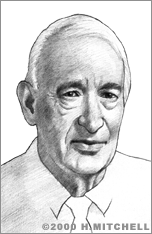Paul Zamecnik
Over the last half century, Paul Zamecnik has revolutionized medical research more than once. Among the highlights of his career are opening the door to the breaking of the genetic code, and creating a new biotechnological discipline: antisense therapeutics.
Zamecnik was born in Cleveland, Ohio in 1912. He came east to attend Dartmouth College where he majored in Chemistry and Zoology (AB, 1933), and Harvard Medical School (MD, 1936). Zamecnik served his residency in Boston, and his internship in Cleveland, then, returned to the Boston area. He began teaching at Harvard Medical School in 1942, and from 1956 to 1979 he was both a Professor there and a Physician at Massachusetts General Hospital.
Zamecnik's international fame as a pioneer in biotech research was established in the 1950s. His first major success was leading the lab that invented the first cell-free system for studying protein synthesis (1953). This led to basic discoveries of just how proteins --- ubiquitous in living cells --- are synthesized from the genetic code of DNA. It also led indirectly to the breaking of the DNA code: an achievement that Zamecnik and his colleagues left to others, whose progress is reported regularly in the media today.
In 1956, Zamecnik identified "transfer RNA" (tRNA), the nucleotides that convert the code of DNA into proteins. His next task was to determine how that transfer process worked. Zamecnik became the first scientist to observe and report the way in which tRNA aligns itself across messenger RNA on ribosomes in order to facilitate the adaptation of individual amino acids in protein synthesis.
Some researchers feel that Zamecnik deserved the Nobel Prize in Medicine for these advances alone. But some years later, he found an even more impressive application for his early work. Zamecnik reasoned that he could develop a method to block the process of protein synthesis selectively: that is, to deny a virus or cancer within a cell the proteins it must have to survive.
Zamecnik intended to use certain synthetic oligonucleotides (which he proved could pass through cell membranes) to block the "message" of a cell’s tRNA by a process he called "hybridization arrest." Scientists then knew the RNA sequences unique to a variety of diseases. Zamecnik saw that a tRNA sequence that was the "negative image," or "antisense," of the sequence needed by a diseased cell to synthesize protein would neutralize the latter, preventing it from receiving the message. Zamecnik would use nucleic acids to carry the blocking RNA and bind it to the RNA in the diseased cells: as a result, the diseased DNA or RNA replication would stop cold.
Most biochemists were skeptical. In a landmark publication on "Gene Expression Modulation" in 1978, Zamecnik proved the skeptics wrong. His paper inspired an entirely new field of biotechnology, antisense therapeutics. The next year, Zamecnik continued his work as Principal Investigator at the Worcester Foundation for Biomedical Research. He and his colleagues made steady progress, including some success blocking HIV with an antisense oligonucleotide (1986).
Today, several companies, with total assets of over $1B, have been founded exclusively to work in antisense biotechnology. Among them is Hybridon, Inc., which Zamecnik co-founded in 1990. He conducted and supervised research at Hybridon six days a week, in the areas of antisense and chemo-therapeutics, combating influenza, malaria, and AIDS. As Zamecnik said, "The lab is where the action is."
Paul Zamecnik earned over a dozen U.S. patents for his therapeutic techniques. He has also won many distinguished awards for his work, the National Medal of Science (1991) and the first-ever Lasker Award for Special Achievement (1996). Zamecnik passed away on October 27, 2009 at the age of 96.


